People
Pérez Art Museum Director Franklin Sirmans on What Caught His Eye at Miami Art Week
Sirmans also reflected on his nearly decade-long run at the Miami institution.
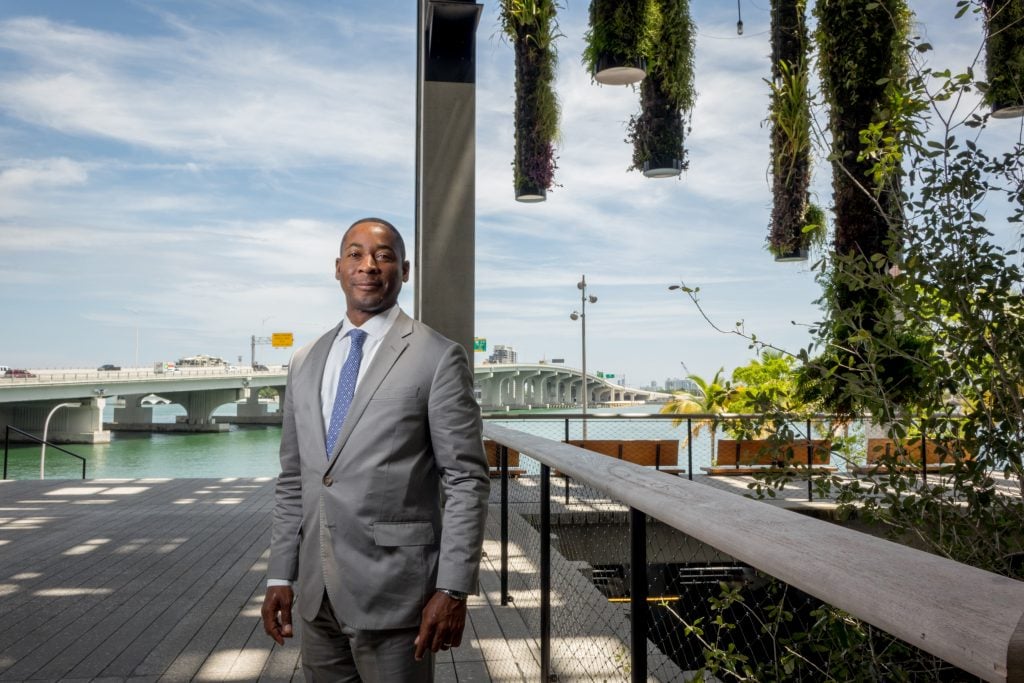
Sirmans also reflected on his nearly decade-long run at the Miami institution.

William Van Meter

Yesterday afternoon as Miami Art Week was cresting, one of the city’s key players, Franklin Sirmans, was sitting on the grand back steps of the Pérez Art Museum Miami and looking out over Biscayne Bay. South Beach is just a bridge and a few miles away, but many Art Basel attendees never cross it—except to visit PAMM, the art world’s go-to mainland destination.
Sirmans has been the museum’s director since 2015, during which he has prioritized presenting the work of Caribbean and Latin American artists—he spearheaded its Latin American and Latinx Art Fund in 2018—deepening the institution’s ties to the local community. He also guided the museum through the challenging waters of 2020, leading its digital programs that featured interviews with David Adjaye and Futura, among other artists.
Open and garrulous, Sirmans was enjoying a coffee, a chocolate chip cookie, and a brief respite from this week’s packed itinerary. Added to the cacophony of the whizzing overpass traffic was a construction crew with multiple forklifts setting up the stage for tonight’s blowout featuring a performance from George Clinton of Parliament-Funkadelic.
The party will perfectly cap off a big week for PAMM. Gary Simmons’s impressive “Public Enemy” opened at the museum earlier in the week. The 30-year knockout survey is a powerful testament to Simmons and a timely primer for a mass audience who is catching up to having the conversation he’s been exploring for 30 years. Sirmans has a personal history with the artist as well.
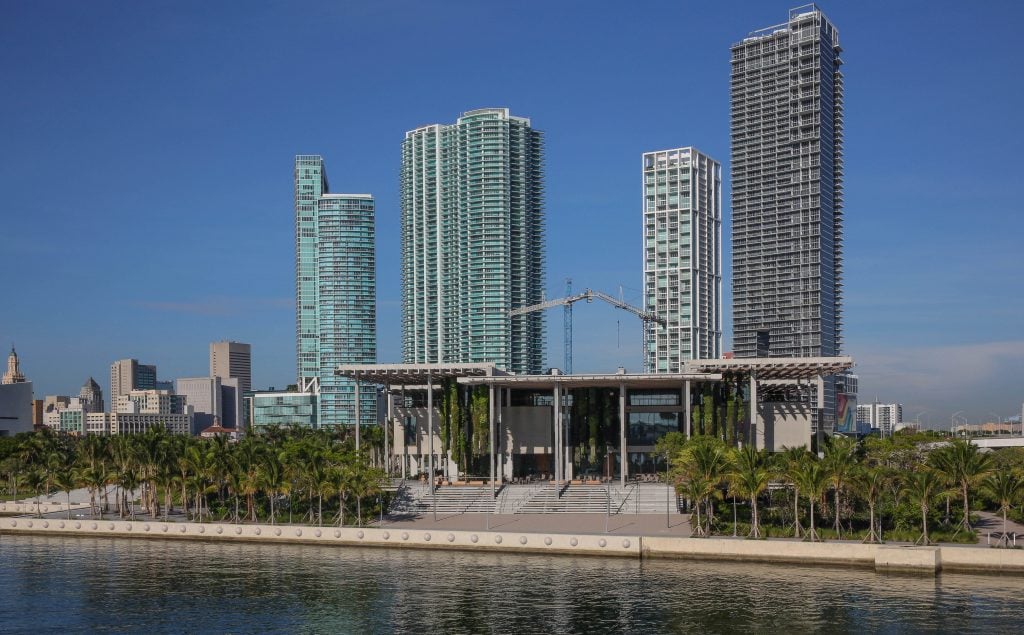
Pérez Art Museum Miami. Photo by Daniel Azoulay Photography.
Sirmans is optimistic about the museum’s path forward and sees it as continuing to lean on the strengths of its DNA. He recalls how inspired he was by the multicultural board when he joined. “I can’t think of another institution where you had that level of diversity,” he said. “And it was already like that! There was already a foundation there. What we’ve tried to do is lean into that initial foundation and say that we’ve gotta be the best at representing Latin America and the Caribbean. And we look toward the African diaspora. If you try to be something else, you’re crazy. Actually saying that and embedding that into our mission and vision has been really transitional.”
“The other thing that I benefit from is that people gave Jorge Pérez a lot of slack for putting his name on the building. But there are not that many museums in our country that have the name of a Latino American on them. That’s been an amazing gift. It opens up the conversation in so many ways.”
Here, Sirmans reminisced about his art world forays and time at PAMM.
I think a lot of people have a myopic view of Miami—that the art scene is relegated to Miami Art Week and that the city is just South Beach. What has the art scene evolution been like here since you came to PAMM in 2015?
It didn’t come out of nowhere, but there has been exponential growth in the last five years. There’s an incredibly vibrant community that’s happening all the time, and it’s one that is invigorated by its proximity to Latin America and the Caribbean. So many artists have come here. I hate to say it like this, but think about what happened in Cuba in terms of artists leaving. They all came here for the most part, right? And they’re top caliber international artists who are showing all over the world, are teaching the next generations in the museums and universities. José Bedia lives right down the road. Edouard Duval Carrié is on the Haitian side because a similar huge body of people are coming from there. He lives right up the street and has a studio there and artists there and people there all the time.
There’s this vibrant space that has been continuous among people who find Miami to resonate and to be receptive to their work in ways that other places might not have been until recently. And that’s massive. But it continues—you see it in the Bakehouse Art Complex, Locust Projects, the Miami Light Project residency over on the beach. There are these hubs for working artists to have studio space. That’s been integral for the growth of the last few years.
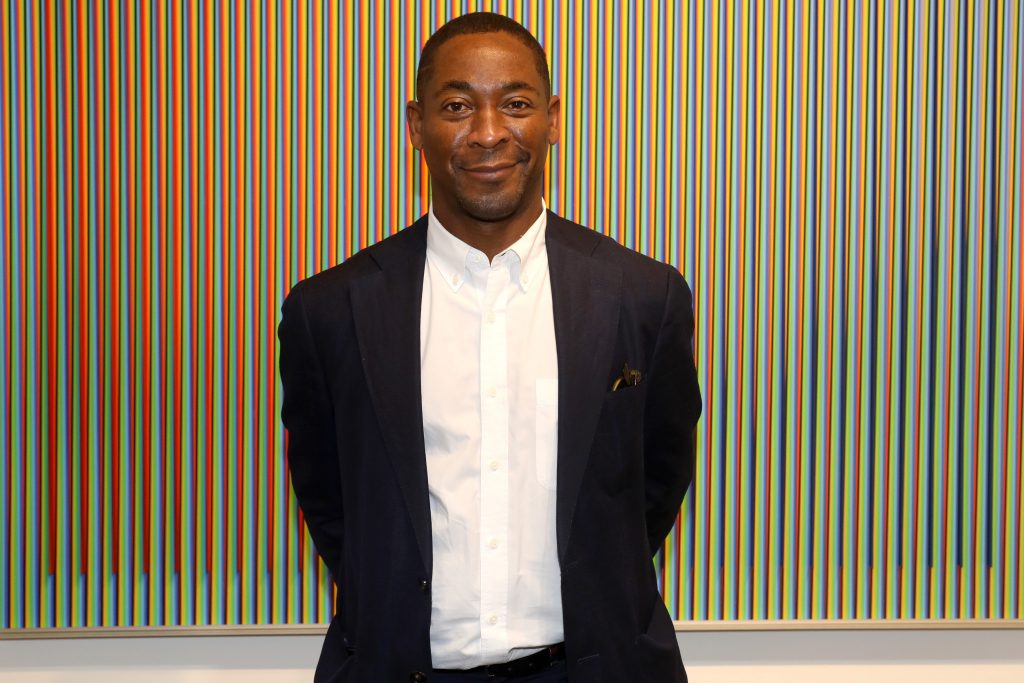
Director of the Pérez Art Museum Miami, Franklin Sirmans, at Art Miami + Context Art Miami VIP Previews on November 30, 2021 in Miami, Florida. Photo: Aaron Davidson/Getty Images for Art Miami + Context Art Miami.
So what has your art week been like so far?
Well, the Collector’s Council met first thing in the morning today and every year we walk into the fair together. It’s really fun! It’s like 40 or 50 people. Some of them think you’re gonna give them a tour. That’s not gonna happen. But we have a social moment beforehand and then go in together and have that camaraderie. So, we did that this morning and spent a few hours at Basel. Tuesday, I’m across the street at Art Miami. I was there for their opening early evening yesterday, and that’s every year. Clockwork: 4:30 we go over there.
With fairs in general, I find I can walk in jaded and turned off by the bad lighting and sample sale atmosphere and then be struck and moved by the discovery of a new artist. Have you seen anything this week that you’ve thought was particularly fab?
[Sirman takes out his phone to flip through some photos he took at the fairs] There’s a young woman from Baltimore that I saw at Context at a gallery called Band of Vices last night: Monica Ikegwu, a painter whose work I’d never seen in person. It was nice to see that. It’s basic portraiture, but just shocking the way that she treats the eyes. This is Sheena Rose. She’s a wonderful artist who’s shown here before from Barbados. I’ve never seen that before. This is [Emmanuel] Araújo, the Brazilian artist. We have a painting, but we would like to have a sculpture as well.
That was at Jack Shainman. This is a local artist in the Meridians section, Reggie O’Neill, who we already have in the collection. I was excited to see that 1976 Grace Hartigan crazy American painting. It’s all over the place. This is a young artist from here, Jenny Sanchez. I don’t know what to make of them yet. They’re almost portraits inside of these constructed canvases and they really look weirdly like Impressionist paintings instead of portraiture.
I’m all over the place right now. I usually go to NADA on Thursdays. Our team has already been there and selected a photograph for us to acquire. We have a deal with Scope. So, our chief curator was there and got something from an artist named Deborah Jack, who’s been in a group show here, but we don’t have in the collection.
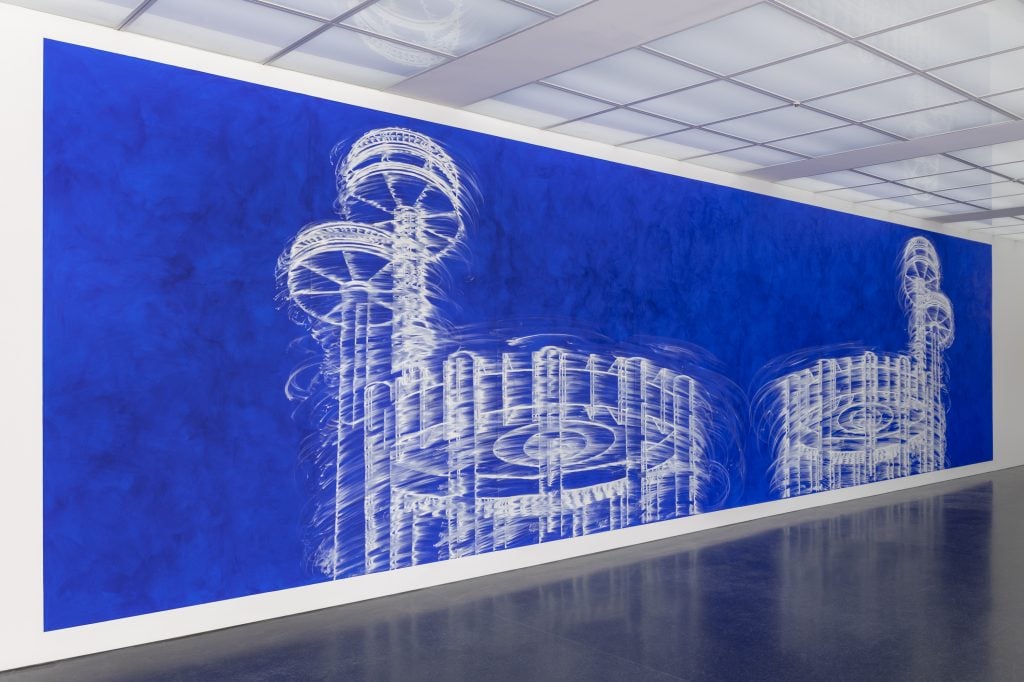
Gary Simmons, Reflection of a Future Past (2006), on view at “Gary Simmons: Public Enemy,” MCA Chicago. Photo: Shelby Ragsdale, © MCA Chicago
Gary Simmons’s “Public Enemy” opened on Tuesday. This is a very personal show for you to have here and you guys go back a long way.
[The curator] Thelma Golden introduced me. I was probably still in school at Wesleyan where I graduated in 1991, and we met around that time. I immediately recognized that we shared some passions, and that was really it. We’ve worked together several times over the years, but it really is more of a friendship than it is a working relationship.
What was your initial reaction to seeing his work? Were you aware of the broader cultural significance he would attain?
The first thing I remember is the “erasure drawings” and he was doing them on little pieces of paper and Simon Watson showed them around that time. That was the base, and it still is many in many ways, but a lot of sculptural work was also around this time—Disinformation Supremacy Board, which is in the MoMA collection, this big paragraph made out of erasers. I was really into writing and doing poetry readings at the Nuyorican Poets Cafe. So, I was there a lot and it all co-mingled. Bob Holman, who was married to Elizabeth Murray, was the ring leader in some ways, so he was part of that world. Anyway, Gary decided that there was enough interest in the art and the ideas that we were gonna do a show together.
We did a show together in 1993 called “Guess Who’s Coming to Dinner” which is softly based off of the Sidney Poitier movie. It’s one of those things where you’re just living, you’re just doing it. It’s impulsive, it’s intuitive. I wasn’t thinking that hard about the work; it was more like a figment of our time. I think the way that he spoke about hip hop—wanting to relate to the music that was coming out in that moment and feeling a kinship to that—was also part and parcel.
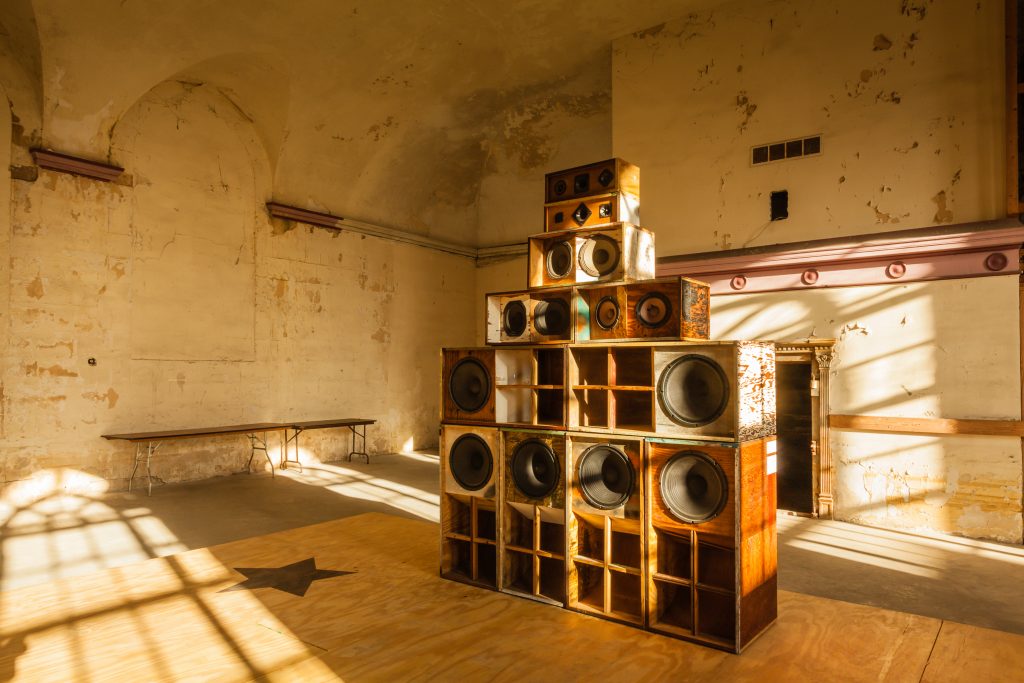
Installation view of “Gary Simmons: Recapturing Memories of the Black Ark,” 2014–15. Prospect 3, New Orleans, Louisiana. Courtesy of the artist and Hauser & Wirth, Los Angeles. © Gary Simmons. Photo: Scott McCrossen/FIVE65 Design.
You’ve been a writer, poet, and curator. There is joy to not being the boss, to not have to deal with the business aspects of something. But this role seems to be something you flourish in. Did you have a career path to get here?
It’s totally fulfilling. It’s the marriage of all of the things you mentioned. I’m not saying I have a deep interest in in bureaucracy or anything, but I like the structure of who we are. I like the idea of being a bridge between a board of trustees and a staff. I like that I get to work with people who are in college and with somebody who celebrated their 95th birthday here last week. There’s something to that that I find really rewarding. And I actually do like the business of it, and I like the business of museums in the sense that yes, we’re trying to do something that is on one hand social community based. I know we use that word in elastic ways, but at the same time, it caters to an idea of entertainment, an idea of beauty, an idea that art has a place in everybody’s life. That’s the balance for me. I love it. And at times it is absolutely challenging. But for the most part, I couldn’t imagine doing something else at this given moment in time.
I thought at first, I would be a writer. I did English and art history as an undergrad and immediately was able to write criticism after school for Art News, Publisher’s Weekly, and a bunch of smaller alternative magazines, all of these little outlets in which you could express yourself. One of them was Beat Down magazine, which is more a music magazine and we had a cover for the Whitney Biennial lineup. So, it was like, okay, figure out a way to be a writer. You know, you’re probably gonna have to do some teaching and you cobble it together. I lived in a rent stabilized apartment. It was working, but in the process of teaching 20th Century Criticism, it got to a point where it was, like, it’s awesome to think about and write about the things. At a certain point, I wanted to move the objects physically and that’s when I turned to more of a curatorial stance and went to Houston in 2006 and worked at the De Menil collection. Prior to that, I was at DIA in publications, next door to curator Len Cook.
Then I went to Italy to work for Flash Art. I was in Milan for two years, and it was two really, really interesting years because it was ’96 to ’98, at the beginning. At the end of ’96, Peter Weibel did a show in Austria, “Inclusion/Exclusion,” and it was one of those first big, massive shows that attempts to bring together humanity in all of their individual concerns under one collective roof. I think that was an influence on people like Okwui Enwezor, who did the ’97 Johannesburg Biennial. Harald Szeeman, although he had been in the game for a really long time in ’97, does Lyon and Venice once again. I got to sit in the curatorial studio with Szeeman.
So, the world opened up in a way. I didn’t go to graduate school, but that was graduate school. The bar down the street from where we lived in at that time also happened to be [frequented by] Vanessa Beecroft. Maurizio Cattelan lived right around the corner. It was this weird moment, a wonderful time to be there. And from there to go to South Africa for the Biennial, and have that proximity to Europe, and get lost with artists in Slovenia—just crazy things that you can only do at a certain point in life. And then coming back it, it slowly turned into, well, how do we make this work in a more institutional context?
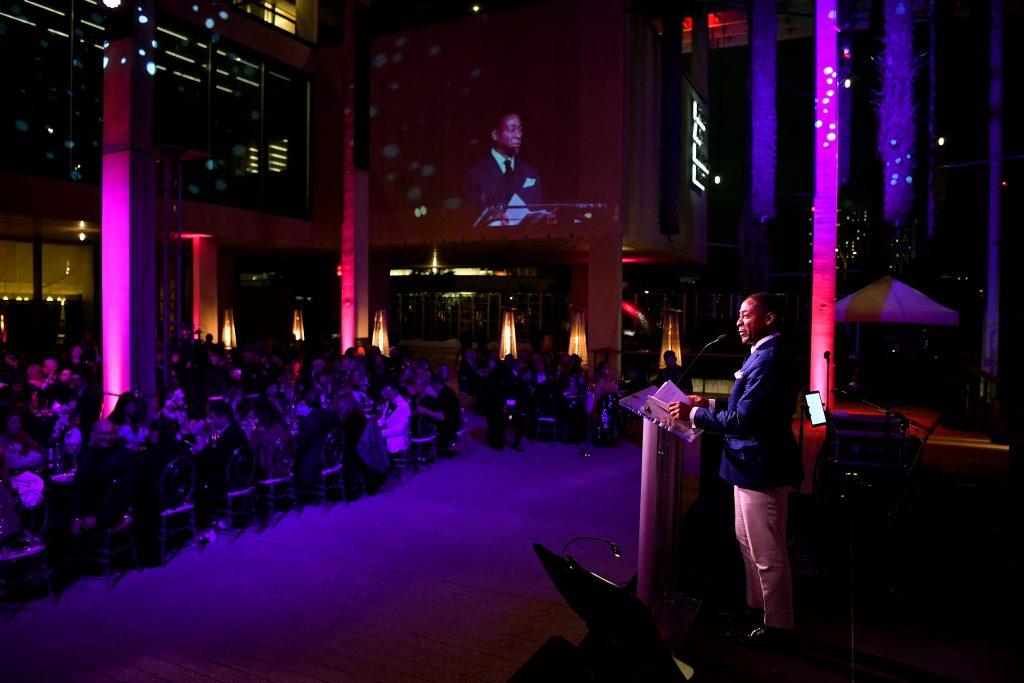
MIAMI, FLORIDA – MARCH 12: Franklin Sirmans speaks onstage during the Pérez Art Museum Miami Art of the Party at Perez Art Museum Miami on March 12, 2022 in Miami, Florida. (Photo by Jason Koerner/Getty Images for PAMM)
I think a lot of museums since 2020 haven’t changed their outlook. Attendance has dropped, and raising prices to $50 will further this.
I couldn’t agree more. We’ve made good use of the building in terms of the balance between special events and our events. It is a facility that’s been helpful as far as revenue goes. We’re in Miami, we’re not in New York. We’re in a different kind of competitive environment. We can take some chances and if something doesn’t work, then we can try something different. Even if it’s just making sure you have local musicians and artists out here on Thursday night, it’s giving them an outlet for their creativity and creating a space for us to continue programming. So, we’ve been trying to really lean into Thursday nights. Second Saturdays are our biggest days when the museum is free and it has a family element. There’s always art-making and performance around that.
What are you looking forward to in 2024 for PAMM?
I’m happy [to have] the Gary Simmons exhibition, which will be up the first three-and-a-half months of 2024. And then I’m excited that our chief curator, Gilbert Rio, will be bringing in his first big exhibition, a show called “Chicana Body,” which is out in Riverside at the new The Cheech museum. It’s gonna be interesting to see the ways in which what is more identifiable as a West coast or southwest Latino population presence culturally plays here.